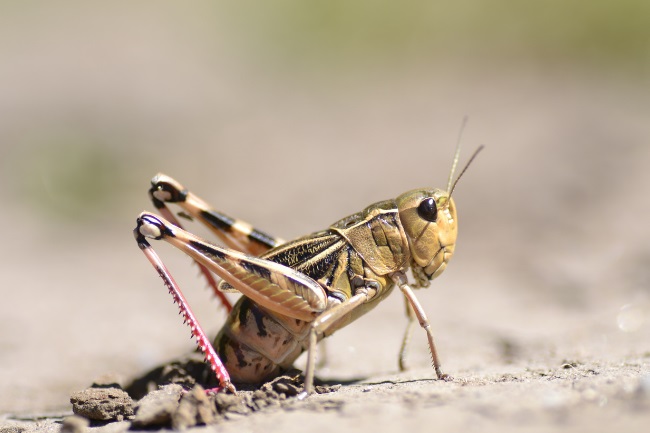Grasshoppers do not have an internal spine, this means that they fall into the category of invertebrates. Other invertebrates include molluscs, other arthropods and annalids, such as earthworms.
Contents
What is an invertebrate?
Invertebrates are a highly diverse group, and make up the vast majority of animals. The group contains those animals that don’t have vertebra. Vertebra make up an internal spinal column, and are usually part of a larger endoskeleton, a skeleton that sits within the skin, rather than outside it.

The spinal cord is made up of sections of bone or cartilage, which connect together to allow the animal to move. Vertebrates have brain, which sits within a skull, and column of nerves down the spine. They also have an organised body shape, with a mouth at the head end of the body, connected through a gut system, ending in the anus. They also have limbs and other features that to go in pairs, and tend to be located symetrically down the body.
| Characteristic | Invertebrates | Vertebrates |
|---|---|---|
| Backbone | Lacks a backbone or vertebral column | Possesses a backbone or vertebral column |
| Body Structure | Diverse body forms, exoskeleton, or hydrostatic skeleton | Bilateral symmetry, internal skeleton, or endoskeleton |
| Nervous System | Varies from simple to complex | Highly developed central and peripheral nervous system |
| Reproduction | Varied reproductive strategies, including sexual and asexual reproduction | Typically sexual reproduction |
| Respiratory System | Varies, including gills, tracheae, spiracles, or diffusion through the body surface | Gills, lungs, or other specialized respiratory organs |
| Examples of Organisms | Insects, spiders, worms, mollusks, and crustaceans | Fish, amphibians, reptiles, birds, and mammals |
Vertebrate species include mammals, birds and fish, among other groups. Invertebrates are a much more random group, with the lack of a vertebra often being the only thing to connect them. Molluscs such as slugs are invertebrates, as are arthropods, such as spiders. The group ranges in size from some of the smallest living creatures, such as nematodes that live in the soil, to some of the largest, such as the giant squid.
Also read: Do Grasshopper Legs Grow Back? (Regeneration Explained)
What makes a grasshopper an invertebrate?

Grasshoppers do not have an internal spinal column, instead having an hardened outer layer of skin, known as an exoskeleton. They do have a cord of nerves that run down their body, however unlike vertebrates it runs the lower part of their body, rather than down the back. Along this highway of nerves are periodic ganglia. Ganglia are bundles of nerves that help control different aspects of the grasshopper’s body, from legs to wings, to their antenna.
This gives different parts of the insect’s body a kind of mini brain, which means they can operate somewhat independently. This is why some insects can be decapitated but still go about their day as if nothing has happened. Death doesn’t wait long though as, unable to eat, they’ll slowly starve. It can also mean that the parts of the insect’s body can react more quickly than vertbrates can sometimes.
| Characteristic | Explanation |
|---|---|
| Invertebrate or Vertebrate? | Invertebrate – Grasshoppers lack a backbone or vertebral column, which classifies them as invertebrate organisms. |
| Exoskeleton | Grasshoppers have an exoskeleton, a hard external covering that provides support and protection. |
| Adaptations for Jumping | Strong hind legs and enlarged muscles allow grasshoppers to perform powerful jumps. |
| Compound Eyes | Grasshoppers have large compound eyes that provide them with a wide field of vision. |
| Sound Production | Male grasshoppers produce sounds by rubbing their hind legs or wings together in a process called stridulation. |
| Herbivorous Feeding Habits | Grasshoppers primarily feed on vegetation, such as grasses and leaves. |
Grasshoppers aren’t so different from some vertebrates however, their digestive system beginning at their mouth and ending at their anus. They also have a highly organised body, with symmetrical bodyparts on the left and right have sides of their bodies. Like all arthropods they have a body made of three parts; a head, thorax and an abdomen. On either side of their body they have three legs, an eye and an antennae.

Not all invertebrates are so straight forward though. Jellyfish are invertabrates too, but do not have such a familiar body form. Instead of a body with a head and limbs attached, jellyfish have a bell shaped hood, that contains their reproductive and digestive organs, but no brain, with a set of tentacles suspended below. Other unusual invertebrates include corals and slugs.
There are exceptions to the rules, as always, with the hagfish being classed as a vertebrate but lacking the full spinal column. It is thought that the hagfish had a spine, but has lost it through evolution. This isn’t the only weird thing about these fish either, having four hearts and the ability to excrete a horrible slimy substance, that makes them almost impossible to catch.
What else is a grasshopper?

As well as being an invertebrate grasshoppers are arthropods and insects. They sit in these categories because of their hard exoskeleton, the body made up of the head, thorax and abdomen, the three pairs of legs, and pair of antennae.
The spineless grasshopper
Like all insects grasshoppers are invertebrates, because of their lack of a spinal column. However, this is only because they don’t need one. The vast majority of animals get by without a spine just fine, having developed alternative means of getting around and other types nervous systems. With around 1.25 million invertebrate species globally, they’re clearly doing just fine.

